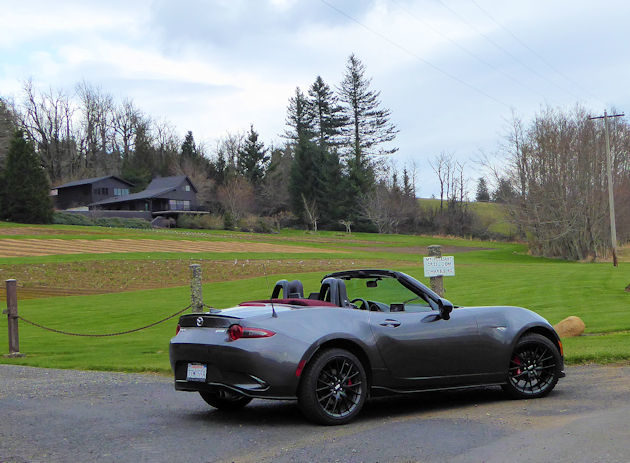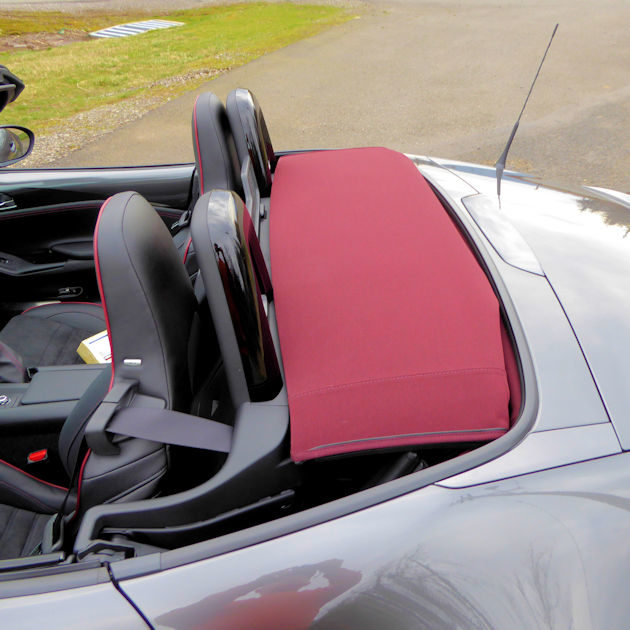By Barbara & Bill Schaffer
Since inception in 1990 the Miata has revolutionized the classic two-seat sports car. Sports cars with names like MG, Triumph and Austin Healy had often been impetus of dreams of young and old Americans, but their reputations for poor reliability and practicality made for limited sales.

The 2018 Mazda MX-5 is available in three trim levels: Sport, Club and Grand Touring. The Club model we tested recently has what Mazda refers to as a ?harder edge? than the other two models, and therefore is a bit better suited for performance driving, or perhaps being better set up to be a weekend racer. The Brembo BBS Recaro option ($4,470) pushes the Club even more toward race-ready. The package includes quick stopping Brembo brakes; forged, lightweight BBS wheels; form-fitting Recaro seats and side still extensions.

The three 2018 Mazda MX-5?s have base prices, including the destination charge, of $26,185; $30,645 and $32,160 respectively. The automatic transmission adds from $600 to $1,350 depending on the trim level.

The first thing that we noticed about the Skyactiv Mazda MX-5 was its looks. We think it is one of the best-looking Mazdas ever. A product of another of Mazda?s Zen-like attributes, the MX-5 was developed from KODO ? which translates to ?Soul of Motion Design?. Whatever it means, the KODO looks great in the classic sports car design of long hood, short overhang with the cockpit pushed toward the back. The profile is low and sleek with the wheels pushed toward the corners and the design line sweeps over the tires conveying a feeling of movement.

It still looks very much like you?d expect a Miata to look like but with new purpose and sophistication. And, it looks good, top up or top down. With the top up the cabin is quiet and solid feeling. Lowering the top takes the twist of a handle at the center of the upper windshield frame and a push of the top toward the rear where the folded top latches into place with a section of the cloth top acting as a flush cover. Raising the top requires releasing a lever between the seat backs and then the top can be easily pulled forward and re-latched to the windshield frame –in just seconds. When the top is down the cabin gets only a minimal wind intrusion with the roll bars behind each seat and a deflector shield between them channeling much of the wind above the passengers. Headrest speakers make listening to the audio system easier when the top is down.

All versions of the MX-5 have LED headlights, which allowed the designers to keep the front end low. In addition, the LED headlights stay cooler, produce a brighter light and weigh less than HID headlights.

Many manufacturers use catchphrases like ?Skyactiv? to describe new and improved technologies, but in Mazda?s case it?s a total-effort philosophy to reduce weight and improve efficiency. We?ve driven and reviewed a sample of every one of the new Mazda vehicles which each have the Skyactiv technology, and we can report that there is a difference.

The MX-5 engine and transmission are both a product of the Skyactiv technology. Combined these two Skyactiv components improve fuel economy by 25 percent which translated to an EPA rating of 26 mpg city and 33 mpg highway. We averaged 30.2 mpg during the week we drove the Miata. The six-speed automatic has a slightly better EPA rating of 26/35 mpg.

The Skyactiv 2.0-liter, DOHC four-cylinder engine is rated 155 horsepower. It?s mounted farther back in the engine compartment on this new model to help lower the center of gravity and improve the roadster?s balance. Our test car was equipped with the six-speed manual with short-throw linkage as smooth and precise as any manual transmission we?ve driven. However, the six-speed automatic is nearly as impressive, with quick shifts made automatically or using the standard steering-wheel mounted paddle shifters. Buff magazines indicate a 0 to 60 mph time of 6.1 seconds for the Miata, and an estimated top track speed of 130 mph.

One of the major accomplishments of the Skyactiv technology is the significant reduction of weight. At 2,332 pounds (2,381 with the automatic transmission) the MX-5 is 150 pounds lighter than the third generation and 182 pounds less than the original 1990 model. The engineers used the ?Gram Strategy? to help shave off every excess gram along with stronger and lighter high-tensile steel. In the end, the weight reduction translates to better performance, agility and safety.

Driving on the winding mountain roads near our home the Mazda Miata felt like it was driving on the proverbial rails. The car feels so precise and well balanced it would have been easy to push it much harder, but we just enjoyed a spirited drive through the mountains. This is one of the best handling cars we?ve driven in the last year.








